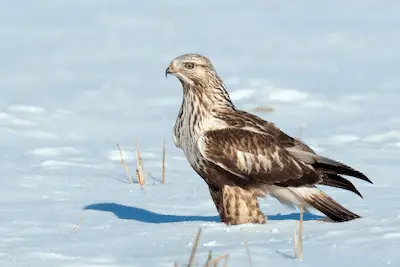Rough-legged Buzzard
(Buteo lagopus)
The Rough-legged Buzzard is one of the largest buzzards in Europe, and is usually observed while wintering in central Europe.

During the summer, Rough legged Buzzards breed in the northernmost parts of Europe, where tundra and sparse taiga are their preferred habitat.
The population of Rough-legged Buzzards changes in cyclical patterns that depend on the population cycles of lemmings and voles in its breeding range.
Rough legged Buzzards are highly migratory, and spend the winter thousands of kilometers south of their breeding grounds.
Rough-legged Buzzard facts
As a northern raptor of Europe, the Rough-legged Buzzard is only seen in central Europe during the winter months.
In spring it migrates north to Scandinavia, Finland and Russia in order to breed.
Rough Legged Buzzard size
The Rough legged Buzzard is one of the largest buzzard species in Europe, and is significantly larger than its close relative, the Common Buzzard.
- Wingspan: 120-150 cm
- Length: 50-60 cm
- Weight: 770-1,650 g (female), 600-1,400 g (male)
But keep in mind that male Rough legged Buzzards are smaller than females, and a small male overlaps in size with Common Buzzards.
Female Rough-legged Buzzards are almost as big as Long-legged Buzzards (Buteo rufinus), and overlap in size with small species of eagle in Europe.
Appearance
Overall, the Rough legged Buzzard looks like a medium sized raptor with long wings and a relatively short, compact tail.

Compared to other buzzard species, it tends to be much paler, with a lot more white in its flight feathers and tail, though pale Common Buzzards sometimes look similar in terms of coloration.
Sexual dimorphism
Similar to most bird of prey species found in Europe, female Rough-legged Buzzards are larger than males, although there is a large overlap in size between the sexes.
Lifespan
A maximum age of 19 years has been recorded in the wild.
Scientific name and taxonomy
The scientific name of the Rough-legged Buzzard is Buteo lagopus. There are 4 known subspecies, of which only one occurs in Europe. Its closest relative in Europe is the Eurasian Buzzard (Buteo buteo), and the two species have been known to hybridize with each other.
Rough legged Buzzard distribution
The Rough legged Buzzard breeds in the arctic and subarctic regions of Europe, and is found in northern Scandinavia, Finland, and Russia. Outside of Europe, its range extends around the arctic and subarctic zones of the entire globe, and it is also found in North America, where it is called “Rough-legged Hawk”.
Rough-legged Buzzard habitat
The Rough-legged Buzzard prefers open arctic habitat, and is most commonly found in the tundra. When it is found further south, it is most common on mountainous regions above the treeline.
While wintering in central Europe, Rough-legged Buzzards are found in a wide range of open habitats, including farmland.
Rough legged Buzzard population size
The European population size of Rough legged Buzzards is estimated to be between 38,000 and 79,000 breeding pairs by BirdLife International, with the largest population in the European part of Russia.
The population size of Rough legged Buzzards undergoes cyclical changes connected to the population numbers of lemmings and voles.
Rough-legged Buzzard behavior
The Rough-legged Buzzard can often be seen hovering at medium height above the ground, and uses this hunting tactic much more often than Common Buzzards.
It’s likely that Rough-legged Buzzards use hovering more often because they are adapted to hunting in open landscapes such as the tundra, which have little to no perches that can be used for still hunting.
Feeding and diet
The most important food source of Rough-legged Buzzards are lemmings and voles, which together compose up to 90% of its diet. The remaining diet is mostly composed of young birds.
While wintering in central Europe, the Rough-legged Buzzard takes a variety of small rodents, depending on the locally available species. During winter, carrion also plays an important part in its diet.
Breeding
The Rough legged Buzzard builds a stick nest on cliffs, mountain slopes, and sometimes trees. The female lays 3-6 eggs, which are incubated for up to 31 days. After hatching, the young buzzards stay in the nest for up to 43 days, and continue to be fed by their parents even after they fledge.
The number of breeding pairs, as well as their breeding success, is highly dependent on the population cycles of lemmings and voles. In years with low rodent populations, very few pairs even attempt to breed.
On the other hand, in years with rodent population explosions, more pairs braid, lay more eggs, and manage to raise more young per brood.
Rough legged Buzzard migration
The Rough-legged Buzzard is a strict migratory species that travels from the arctic and subarctic to winter in central Europe. Even in its winter quarters it is highly attuned to cycles of rodent populations, and moves to regions with explosive rodent populations.
Rough legged Buzzard conservation status
The overall population of the Rough legged Buzzard appears to be stable, and the conservation status of this species has hence been classified as “Least Concern” by BirdLife International. However, it should be closely monitored, to ensure that changes in habitat don’t affect it adversely.
Threats
The biggest threat to Rough legged Buzzards is illegal shooting, which is still practiced by some hunters and game wardens, who mistakenly believe it competes with them for game species.
After illegal persecution, habitat destruction is the biggest threat. This includes building roads through tundra and taiga regions, which often leads to cars colliding with Rough legged Buzzards that feed on carrion.
